Of Magical Realism
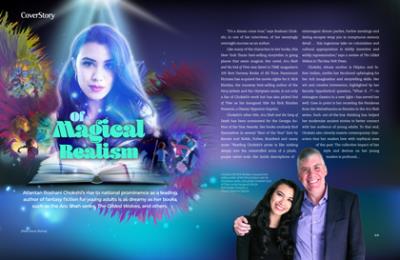
Atlantan Roshani Chokshi’s rise to national prominence as a leading author of fantasy fiction for young adults is as dreamy as her books such as the Aru Shah series, The Gilded Wolves and others.
“It’s a dream come true,” says Roshani Chokshi, in one of her interviews, of her seemingly overnight success as an author.
Like many of the characters in her books, this New York Times best-selling storyteller is going places that seem magical. Her novel, Aru Shah and the End of Time was listed in TIME magazine’s 100 Best Fantasy Books of All Time. Paramount Pictures has acquired the movie rights for it. Rick Riordan, the runaway best-selling author of the Percy Jackson and the Olympians series, is not only a fan of Chokshi’s work but has also picked End of Time as his inaugural title for Rick Riordan Presents, a Disney-Hyperion Imprint.
Chokshi’s other title, Aru Shah and the Song of Death has been nominated for the Georgia Author of the Year Awards. Her books routinely find themselves in several “Best of the Year” lists by Barnes and Noble, Forbes, Buzzfeed and many more. “Reading Chokshi’s prose is like sinking deeply into the overstuffed arms of a plush, purple velvet soda. Her lavish descriptions of extravagant dinner parties, furtive meetings and daring escapes wrap you in sumptuous sensory detail … this ingenious take on colonialism and cultural appropriation is wildly inventive and wildly representative,” says a review of The Gilded Wolves in The New York Times.

[Right] Chokshi with Rick Riordan, runaway bestselling author of the Percy Jackson and the Olympians series, who picked Chokshi’s End of Time as his inaugural title for Rick Riordan Presents, a Disney-Hyperion Imprint.
Chokshi, whose mother is Filipino and father Indian, credits her bicultural upbringing for her rich imagination and storytelling skills. Her wit and creative irreverence, highlighted by her favorite hypothetical question, “What if…?”—to reimagine classics in a new light—has served her well. Case in point is her recasting the Pandavas from the Mahabharata as females in the Aru Shah series. Such out-of-the-box thinking has helped her modernize ancient stories to better connect with her audience of young adults. To that end, Chokshi also cleverly inserts contemporary characters that her readers love with mythical ones of the past. The collective impact of her style and devices on her young readers is profound…
What Roshani Chokshi’s Books Have Meant to Me
Twelve-year-old GIA AGARWAL underscores the cultural significance of Chokshi’s books and shares nuggets from her video interview with the acclaimed author.
 Why do we read books? Why do we gather around the TV waiting for the next episode of our favorite show? Why do we lose ourselves in movies to the point where we start arguing over the “better” Avenger?
Why do we read books? Why do we gather around the TV waiting for the next episode of our favorite show? Why do we lose ourselves in movies to the point where we start arguing over the “better” Avenger?
The answer, I believe, is simple. Human beings love stories. We always have and always will. Books, movies and shows give us precisely that: stories of valiant heroes battling the evil villains, of noble people suffering tragic death, and of the trials and tribulations of passionate lovers.
There are many stories in Indian culture that teach us about honesty, integrity, courage and kindness. Unfortunately, living in the United States, Indian-American kids are often cut off from those stories of our Indian heritage. When a generation passes, who will remember Ramayana and Mahabharata? Who will remember Rama saving Sita, Shakuni’s rigged game of dice, or the teachings of the Gita?
When my school librarian handed me Roshani Chokshi’s Aru Shah and the End of Time, a book based on the Mahabharata, I was skeptical. “Could there even be a good book with an Indian lead?” I couldn’t help but wonder. Boy, was I wrong! From the second I picked up Aru Shah, I couldn’t put it down. That book followed me everywhere: to my school, to the doctor’s office and—much to the annoyance of my mother—to the dinner table. I completely lost myself in the series, learning about Urvashi, the beautiful apsara, and Durvasa, the powerful sage.
The Aru Shah series follows the story of a twelve-year-old girl named Aru who unexpectedly finds out that she’s the reincarnation of one of the Pandava brothers. From that point on, her life changes as she, along with her Pandava sisters, embarks on tales reminding us of the stories we heard as kids.
Chokshi’s words have a way of captivating you. They serve as a portal into the magical world of devas and rakshasas. In Aru Shah and the City of Gold, as Chokshi describes the impending battle, you can see it play out in your head: the rakshasas approaching, and the clanking of swords against shields. Suddenly, you are no longer sitting in your PJ’s snacking on Cheetos, you are in Lanka with Brynne and Mini by your side! Even in Aru Shah and the Song of Death, when Boo is training the Pandavas, the banter between the characters fills your heart with laughter.
I was also pleasantly surprised to see references to some of my favorite characters such as Mulan and Wonder Woman in the middle of a story based on Indian mythology. That certainly made me connect to Aru’s story even more.
Reading the Aru Shah series, I started to appreciate Indian culture and became curious to know more about Chokshi. She was gracious to answer my questions in a video interview.
“What got me inspired to start writing was just the fact that I was a really imaginative bored kid with no particular talent. And I was kind of annoyed that I never saw anybody [in books or movies] that looked like me or my siblings.” Chokshi rued the fact that immigrant kids like her were not represented in popular fiction. She believed there was more to being Indian than appearing as nerdy sidekicks in shows.
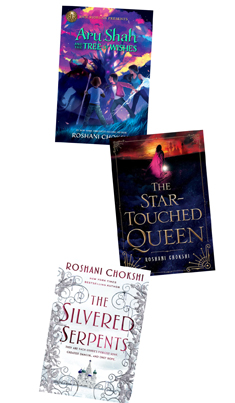 Not surprisingly, Chokshi gravitated towards fanfiction—popular titles rewritten by amateur fans in their own images. She wrote stories about her and her best friends having powers and going on adventures. “For better or for worse, fanfiction was the place where I felt that I got to sort of carve a space in the world for me,” she said.
Not surprisingly, Chokshi gravitated towards fanfiction—popular titles rewritten by amateur fans in their own images. She wrote stories about her and her best friends having powers and going on adventures. “For better or for worse, fanfiction was the place where I felt that I got to sort of carve a space in the world for me,” she said.
Growing up in a mixed-race home, she would listen to Filipino stories from her mom and Indian fairytales from her Ba (paternal grandma) and Foi (aunt). In her books, she wanted to play with these stories that she had heard. She felt that children’s literature was the best place to do that. Chokshi explains, “When you’re on your deathbed, you’re not going to be thinking about the book that won the Pulitzer Prize in 2014, but you will always remember how Beauty and the Beast ended. You will always know at least one tale of Krishna when he was young and mischievous because those stories, in my opinion, are immortal.”
As a child, Chokshi had watched Sailor Moon, a Japanese animated television show telling the story of five friends with superpowers. Chokshi loved the girl power of the show and wanted to include that in her stories. When writing Aru Shah, Chokshi was tired of stories with men as leads. She felt that women had just the same, if not more, to offer.
She felt that throughout Indian culture, women always suffered the most. In mythological stories, it was always women who were sent by the gods to distract the sages, yet they were the ones turned into a stone for 1,000 years. Women were the ones who “sacrificed” for the greater good. Why not men? And that’s why, she recreated the Pandavas as five sisters rather than brothers. “I like the idea of handing [women characters] a microphone and asking them, ‘From your perspective, how did this feel? What was it like for you, and in what way are you trying to reclaim your agency and your independence?’” she explains. Chokshi believes, “You have to write the thing that delights you. You have to write for yourself because you never know if there’s going to be an audience, so the person that has to be the happiest is you.”
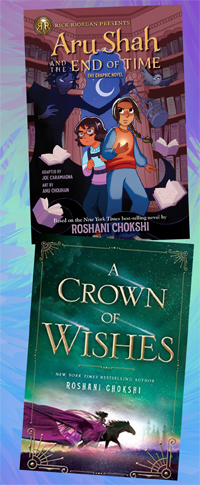 The Mahabharata is overflowing with characters and legends. Chokshi explains that when choosing the stories to include in Aru Shah, she remembered listening to her Ba’s tales. As a kid, she often wondered what happened to the side characters. Like what happened to Uloopi after she saved Arjuna’s life? Who was the bear king who Krishna wrestled for twenty-eight days? If a story had delighted her or made her wonder what happened next, she gave them a chapter in her books. Chokshi always wanted to write stories that weren’t—as she puts it—“married to reality.”
The Mahabharata is overflowing with characters and legends. Chokshi explains that when choosing the stories to include in Aru Shah, she remembered listening to her Ba’s tales. As a kid, she often wondered what happened to the side characters. Like what happened to Uloopi after she saved Arjuna’s life? Who was the bear king who Krishna wrestled for twenty-eight days? If a story had delighted her or made her wonder what happened next, she gave them a chapter in her books. Chokshi always wanted to write stories that weren’t—as she puts it—“married to reality.”
Throughout the Aru Shah series, Chokshi provides a different perspective on many characters from the Mahabharata, keeping readers intrigued even if they are familiar with the stories. Chokshi portrays Shakuni filled with regret and Surpanakha as misunderstood. Once again, Chokshi clarifies, it goes back to the injustice women went through. She adds, “One thing that’s most important about stories is summed up by Alexander Hamilton: ‘Who lives, Who dies, Who tells your story?’ And really that’s what it comes down to: Who is telling your story?”
Chokshi is appreciative that she is able to tell her story of Aru Shah to an even larger audience, thanks to it being picked by Rick Reardan to launch his imprint series. “Rick is a really delightful human being. I really appreciate him for sharing his platform with authors of color and celebrating and plifting all different kinds of mythological traditions.”
Along with Aru Shah, Chokshi is currently working on another series, The Gilded Wolves—a heist novel set in the 19th century in an alternative, magical Paris. “I find Paris in the 19th century such a rich romantic glamorous era and yet it’s a really messed up era—it’s the age of imperialism,” she says.
The last book of the Gilded Wolves trilogy got released in September and the last book of the Aru Shah series releases in Spring 2022.
As both of Chokshi’s series come to end, she plans on trying some new, possibly adult, ideas. She reveals she’s not quite done with Aru and her friends, but she does need a break from teenagers. As a tribute to her mother and her Filipino side, Chokshi is currently working on a novel pertaining to Filipino folklore and mythology, although she is finding it a bit difficult as the rich culture of the Philippines was stamped out when the Spanish forced Catholicism upon the native people of the Philippines. Chokshi worries that she may be “stepping where she can’t see the step.”
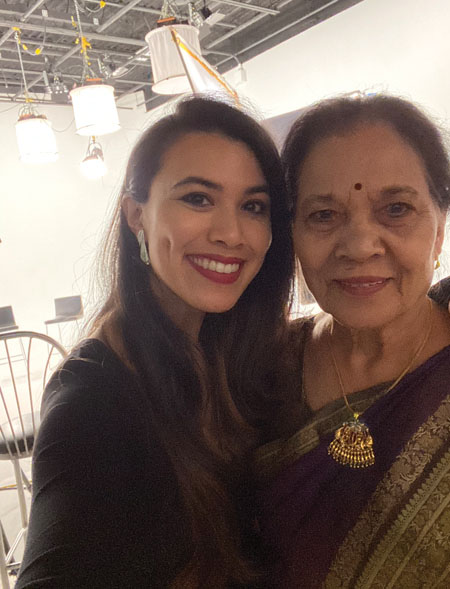 Earlier, Chokshi talked about certain stories being immortal. To me, a story that’s immortal is a story that you just have to recommend to every person you meet. A story that leaves you heartbroken because a pigeon is starved of his Oreos or laughing till your stomach hurts because a crab is being overshadowed by his famous crab brother. It’s a story that changes you.
Earlier, Chokshi talked about certain stories being immortal. To me, a story that’s immortal is a story that you just have to recommend to every person you meet. A story that leaves you heartbroken because a pigeon is starved of his Oreos or laughing till your stomach hurts because a crab is being overshadowed by his famous crab brother. It’s a story that changes you.
Chokshi creates beautiful stories weaving Hindu mythology and pop culture, teaching readers about the Mahabharata in a modern way. She plays with the characters giving them a new life and voice. She makes you laugh with all her Hobbit references (and believe me, there are a lot); and yet somehow, she also makes you cry just a second later. And that’s what a good, no, a great author does. The Aru Shah series, in my opinion, is immortal.
[Top] Chokshi with her Ba (grandmother), who she credits for her love and talent for storytelling.
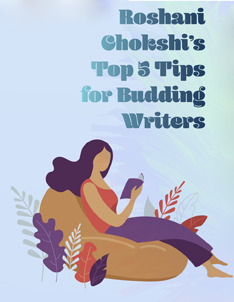
- Steal shiny things. I’m notkidding. We all know plagiarism (in other words, passing off someone else’s work as your own) is the move of a spineless coward, but let’s say you find an idea in a book particularly enchanting. Take it! It is the expression of an idea that makes art, not the idea itself. So make it your own. Consider how you would approach it differently. An “original story” is the world’s greatest fiction, for what makes a story unique is not the plot or the prose, but how it is filtered through your individual perspective.
- Break whatever you want. I love breaking things. Tropes? Smash them. Fairytales? Shake them inside out. Add the words “what if” at the end or beginning of weird sentences and marvel at your freakish idea. When you’re writing, you are beholden to no rules. No one can tame you! You are a vast, omniscient being trudging through a world of your own making.
- Invest in a blankie. First, blankies are very soft. Secondly, sometimes it is hard to find peace and quiet. When that happens, I end up sitting in my closet with a blanket over my head. It also helps me tune out the rest of the world. When you write a story, it’s your name on the front of the book, not the opinions of your family/friends/ mailman/dog/etc.
- Always wink at your reflection. Rejection is a fact of life. If you’ve never been rejected, you haven’t lived. I eat rejection for breakfast. It can be bitter, but eh. C’est la vie. The most important thing about your story is that you like it. You have to believe in yourself with a ferocity that makes your shadow maul whatever other shadow dares to cross it. When in doubt, wink at your reflection and say in your best Joey Tribiani voice: “How you doin?” (Am I dating myself with this reference? Do any of you even know what I am saying?...)
- Ignore everything on this list. If someone tells you how to write a book, they are lying. Here’s why: writing is a solitary, personalized brand of magic. What works for someone else may not work for you, and anyone telling you “This is how to write a book” is flat out wrong. Maybe that’s how they wrote a book, but you are the only you with all that you-ness! Take what appeals. Release what doesn’t serve you. You’ve got this.
Gia Agarwal is a seventh grader at Webb Bridge Middle School. She is an avid reader, loves to write, and has been selected for eight-grade English Language Arts.
On Feminist Recasting, Representation, Cultural Appropriation and more.
Q & A with Roshani Chokshi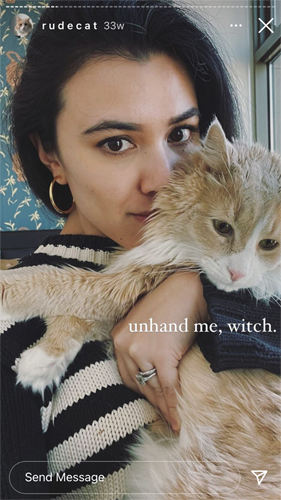
By PARTHIV N. PAREKH
With the Aru Shah series as well as your other books, you have greatly popularized stories from Indian heritage in the mainstream. There is likelihood of Paramount Pictures making a movie based on Aru Shah. How does it feel to be one of the leading interpreters of Hindu mythology in America?
It feels…both wonderful and terrifying. I am honored to be recognized as such, but I sometimes struggle with the unrealistic expectations that come with that. A single person’s work cannot speak for everyone’s lived experiences. When I write, it’s with the full weight of my individual experiences, my Indian and Filipino heritage, and my own biases. My work is not intended to be a mirror, but, hopefully, a light. Maybe some will find it illuminating. Others may find that it’s not showing what they wish to see.
[Right] Chokshi with Theodore, her feline sounding board.
In an interview, you talk about how sensitive you are to the fact that Hindu mythology is so interwoven with Hindu religion and therefore, are careful in your writing about not hurting anyone’s religious sentiments. Yet, magical realism, by its very nature, requires you to take imaginative leaps. Your recasting of the Pandavas as females is one such brilliant creative touch in service of much-needed stories of Girl Power. Can you tell us what kind of feedback you got on this twist?
For the most part, I’ve been fortunate to receive happy feedback. I think one of the highlights of my existence is getting tagged in Halloween photos where kids dress up as the Pandava sisters. That said, not everyone will be happy, and I have to make peace with that. There are some who go into a story with the express purpose of finding something to hate. My work was never intended for that person, so why should I lose sleep that it infuriated them? Other critics may have wanted the story told differently, and to that I say—me too. My hope is that these stories do not exist as a one-off mainstream celebration of Hindu mythology but will help usher in even more retellings and more nuanced takes. A story is very much like a jewel—precious and faceted. And as someone who might have been a treasure-hoarding dragon in a previous life, I don’t think there should ever be a limit on jewels.
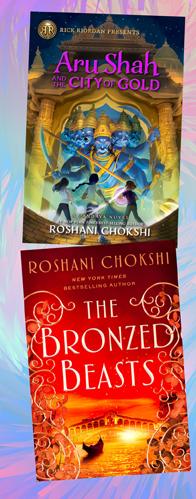 Having the inaugural title in the Rick Riordan series is a major achievement. And it’s easy to see how it has helped your stories reach a larger audience. But do you worry that its overarching influence may impinge upon your style and originality? You said in an interview that Riordon offered a considerable number of edits to your draft.
Having the inaugural title in the Rick Riordan series is a major achievement. And it’s easy to see how it has helped your stories reach a larger audience. But do you worry that its overarching influence may impinge upon your style and originality? You said in an interview that Riordon offered a considerable number of edits to your draft.
Nope. Rick’s wonderful guidance was very much rooted in narrative organization and propulsion rather than individual style. I think mimicry of another writer’s voice is a natural thing for a budding writer (I did it all the time when I was a kid writing and reading fanfiction) but when I wrote Aru Shah, I always knew what Aru sounded like. I always knew what she would say or do or feel, and in large part, that’s because she came from my own experiences as a seventhgrader. So, for better or for worse, I’m afraid no one could change how I wrote her story.
Was The Gilded Wolves an attempt to break free from being slotted as an author of Asian fiction? And was writing it any harder than the Aru Shah series considering you had to immerse yourself in a world that was not native to your background and life experiences?
The Gilded Wolves, hilariously, was born out of an attempt to write something fun, lighthearted and in the vein of my favorite trashy movie, National Treasure. What I ended up writing was the story of a found family with an anti-imperialism middle finger and Faustian torment as a bonus. Although it wreaked havoc on my hands, writing both series simultaneously helped both of those separate worlds come to life. They were so different that it felt like a true mental break from one project to be working on another. They both required very different research too. With Aru Shah, I was revisiting stories my Ba told me. With TGW, I was revisiting the history (again, another story) my teachers had fed me. Both required interrogation.
Do you feel authors of color are boxed-in into their native identity by mainstream publishers? Or do you think that is changing?
I think this is changing. There is tension between the publishing industry aiming to seek out and uplift marginalized voices while also recognizing that people of color are not a monolith. One voice does not speak for all.
On the lines of not being boxed- in by one’s skin color or race, what do you make of the accusation of cultural appropriation lobbed at white folks who make a career out of their passion for ethnic things or simply flaunt them in a casual manner? Since we no longer live in colonial times, and there’s really no pervasive power differential between whites and,let’s say, Indian-Americans, are such accusations of cultural appropriation appropriate?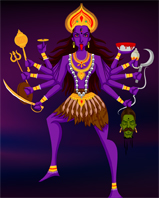
As with anything, it depends. Sometimes the outrage is justified. For example, I don’t think celebrities dressing up as Kali Ma for Halloween is appropriate. But I also wouldn’t condemn a white person for wearing a necklace with Sanskrit scripture or a representation of a deity. I don’t know their life story. What if it has a particular and specific meaning to them? What if they derive comfort and peace from that? Who am I to possess and limit the reach of a deity?
Some of those who only know of your outsized success as an author may envy you. And yet you have been down and vulnerable just like the rest of us. Can you speak a little about how professional success alone cannot be our salvation?
I think I’d envy me too if I only saw the stuff I share on Instagram. Professional success is a game of smoke and mirrors. On the days when I’ve shared the best news, I have also had my worst lows. When I think of success, I no longer include the word “professional” in the assessment because it’s fleeting, subjective and far too frail a thing. We have this misconception that success must be an immediate consequence of an action, and that is the most poisonous fiction. We cannot predict how the evershifting attitudes of society can gild or stain an accomplishment. At the end of the day, we only answer to ourselves. When I write, I give that project my best effort. But when I finish a book, it ceases to belong to me. Its reception lies beyond my control, so its assessment as a success or failure feels just as removed. This approach—made possible by a fantastic support system of friends and family and therapy— gives me peace.
You have a great sense of humor. I can totally see you do well as a standup comic. Have you ever considered that, just for fun?
I’m delighted you think so! Writing is, as I’ve said, wildly solitary, so oftentimes I’m laughing by myself or engaging my cat (Theodore) in imagined conversation. I don’t know that I would trust myself in front of a human crowd. For now, it’s probably in everyone’s best interest that I keep my thoughts to myself.
Parthiv N. Parekh is the editor-in-chief of Khabar magazine.
Rapid Fire with Q & A with Roshani Chokshi
Your favorite Rick Riordan book? The Kane Chronicles
Your favorite non-fiction book? Fallen Glory: The Lives and Deaths of History’s Greatest Buildings by James Crawford
Your top three Amar Chitra Katha titles? Shiva Parvati (I thought this was the most romantic thing in the world as a kid…I still do); Great Plays of Kalidasa; and Tales of Narada! And all the Krishna stories!
Your best binge-watching experience? For historical romance, Poldark. For pure joy, Ted Lasso. For something that will make you question existence, Dark on Netflix.
Your favorite Hollywood movie? Pride and Prejudice
Your favorite Bollywood movie? Jodha Akbar (Favorite Tollywood movie is Bahubali)
Your favorite “other” movie or documentary? Spirited Away by Hayao Miyazaki
Your favorite Gujarati food indulgence? I really love my Ba’s khichdi. When I was a kid, she used to roll it up in tiny mounds while I would abuse the amount of ghee and yogurt I’d pour on top.
Your favorite Filipino food indulgence? I am obsessed with Filipino sweets. My absolute favorite is a cake called sapin-sapin! It’s a multi-layered, glutinous rice cake that looks like stripes of purple, yellow and white. It is like eating a sunset.
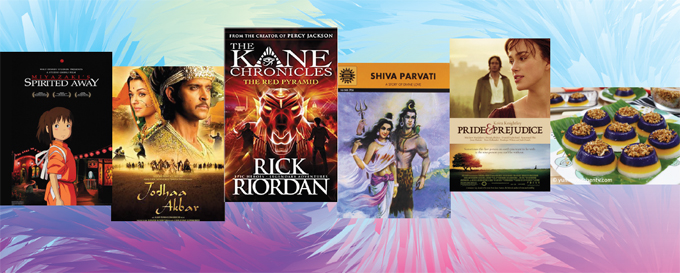
Enjoyed reading Khabar magazine? Subscribe to Khabar and get a full digital copy of this Indian-American community magazine.
blog comments powered by Disqus










